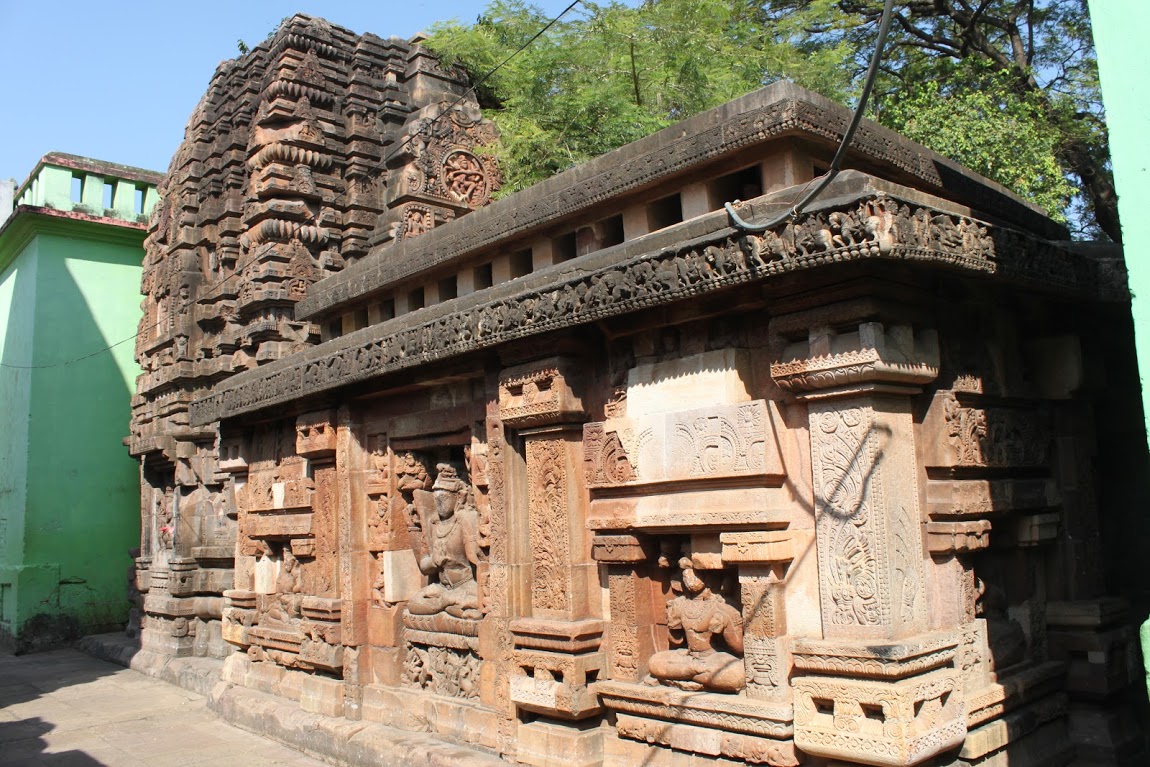This temple is located in the same compound as of the famous Vaital temple. Both these temples may appear coeval however, on architectural grounds, Sisireswara would be a predecessor of Vaital. In this respect, it resembles a lot with its predecessor, Markandesvara Temple, to the extant that scholars have pronounced it as the replica of the the latter, with few added innovations. Donaldson1 has dated the temple in 775 CE, after Markandesvara and before Vaital Temple.
It measures 13 feet square at base, smaller in size than the Markandesvara Temple. The deul and jagamohana were constructed as a cohesive unit. Entrance into the temple, through Jagamohana, has two large pillars. The pillars have three bands, the inner two bands are decorated with dvarpalas. The dvarpalas are shown with four arms, carrying a trisula (trident), one representing the terrifying Nandi aspect while another resembling Mahakala aspect. The entablature supported on these pillars is decorated with the designs of chaityas, hamsas (swans), lotus rosette and various geometrical scroll-work. The lalata-bimba has Gaja-Lakshmi motif.
The rectangular jagamohana is 19 feet long and 16 feet wide. It has been recently restored with a new added roof, resulting in a terraced roof sloping in two stages with a clerestory, an arrangement very similar to Parasurameswara Temple. Narrative scenes are sandwiched between the sloping eaves. Among these various scenes, the story of Kiratarjuniya is evident with depiction of the battle scene between Arjuna and Shiva. Among the images in the niches, important ones are of Kama, standing Shiva, a naga and Lakulisa. The naga image is identified with Amoghasiddhi by Panigrahi2 however Donaldson3 does not agree with this identification.
The Lakulisa image, housed in the central niche on the south side, is very interesting. He is shown with four hands, his major hands are in dharma-chakra-pravarttana-mudra. In his other two hands, he holds a rosary and a lotus. His lakuta (rod) is resting on his right shoulder. He is accompanied with six disciples, three placed on either sides in shallow niches. On the pedestal is a lotus and a triratna symbol, flanked by a deer and a naga on either side. This pedestal device resemble very much to that of the Sarnataha image where in the latter the lotus is replaced with a wheel. This is a very convincing evidence of the Buddhist influence coming from the artist guilds who earlier worked on Buddhist sites of Ratnagiri hills.
Deul is tri-ratha in plan and with niches on offsets. This design results into fives niches on each side, except the front where the design is interrupted for the connection to Jagamohana. Donaldson mentions that this five niche design made numerous scholars to qualify this temple as pancha-ratha. Raha-niche starts above pabhaga and has tala-bandhana of projecting blocks at the bottom. Eight blocks are seen on north side and nine are on south side niche. This is the first appearance of this design element on the raha-niches as in the earlier temples, this design was used for subsidiary niches.
All parshva-devatas are in situ. Ganesha is on south, Kartikeya on west and Mahishasuramardini on north. Ganesha is shown seated in ardhaparyanka-mudra, where his right knee is tied to his stomach with a sarpa-patta (snake-band). He is shown carrying a rosary, kuthara (axe), vessel (modaka-patra) and radish. Mahishasura-mardini is eight-armed carrying sword, trisula, shield, bow and a serpent. The image is very dynamic and the goddess is in process of pushing her trisula into the buffalo-demon Mahishasura. Avarana-niches has various Shiva aspects, starting on southeast, Ardhanariswara, Hari-Hara, Gangadhara, Ekapada, Bhikshatanamurti and Bhairava. Panigrahi44 identifies the Bhikshatanamurti as Avalokiteshvara however Donaldson5 goes with Bhikshatanamurti.
Kanika-niches are presently occupied by alasya-kanyas (damsels). Donaldson6 is of opinion that depiction of these damsels was the start of promoting female icons in the overall decorative program of a temple. And this probably also suggests the influence of Saktisim where erotic imagery became very popular. Sisireshwara temple is the first specimen where female icons and erotic imagery found place at major niches. The erotic and sexual imagery sometimes goes very haywire as on the north, some of the niches and chaitya-medallions show explicit mithuna images showing sexual acts between men and animals, a horse and a bovine.
Eight-arms Nataraja adorns the upper chaitya-medallion on the front façade vajra-mastaka. Nataraja is shown in chatura-posture, with his left leg slight raised above the ground. His major left arm swings across his chest in gaja-hasta-mudra while his right hand is in kataka-mudra. He is shown in urdhva-linga posture accompanied with Nandi between his legs. while the lower rectangular niche is empty.
Notes:
1 Donaldson, T E (1985). Hindu Temple Art of Orissa. Brill. Leiden. ISBN 9789004071742. p 88
2 Panigrahi, K C (1961). Archaeological Remains at Bhubaneswar. Kitab Mahal. Cuttack. p 38
3 Donaldson, T E (1985). Hindu Temple Art of Orissa. Brill. Leiden. ISBN 9789004071742. p 91
4 Panigrahi, K C (1961). Archaeological Remains at Bhubaneswar. Kitab Mahal. Cuttack. p 39
5 Donaldson, T E (1985). Hindu Temple Art of Orissa. Brill. Leiden. ISBN 9789004071742. p 92
6 Donaldson, T E (1985). Hindu Temple Art of Orissa. Brill. Leiden. ISBN 9789004071742. p 94

